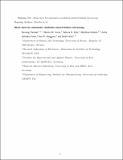Atom sieve for nanometer resolution neutral helium microscopy
Author(s)
Flatabø, Ranveig; Greve, Martin M.; Eder, Sabrina D.; Kalläne, Matthias; Palau, Adrià Salvador; Berggren, Karl K; Holst, Bodil; ... Show more Show less
Downloadatomsieve_preprint_qnn.pdf (5.435Mb)
Open Access Policy
Open Access Policy
Creative Commons Attribution-Noncommercial-Share Alike
Terms of use
Metadata
Show full item recordAbstract
Neutral helium microscopy is a new tool for imaging fragile and/or insulating structures as well as structures with large aspect ratios. In one configuration of the microscope, neutral helium atoms are focused as de Broglie matter waves using a Fresnel zone plate. The ultimate resolution is determined by the width of the outermost zone. Due to the low-energy beam (typically less than 0.1 eV), the neutral helium atoms do not penetrate solid materials and the Fresnel zone plate therefore has to be a free-standing structure. This creates particular fabrication challenges. The so-called Fresnel photon sieve structure is especially attractive in this context, as it consists merely of holes. Holes are easier to fabricate than the free-standing rings required in a standard Fresnel zone plate for helium microscopy, and the diameter of the outermost holes can be larger than the width of the zone that they cover. Recently, a photon sieve structure was used for the first time, as an atom sieve, to focus a beam of helium atoms down to a few micrometers. The holes were randomly distributed along the Fresnel zones to suppress higher order foci and side lobes. Here, the authors present a new atom sieve design with holes distributed along the Fresnel zones with a fixed gap. This design gives higher transmission and higher intensity in the first order focus. The authors present an alternative electron beam lithography fabrication procedure that can be used for making high transmission atom sieves with a very high resolution, potentially smaller than 10 nm. The atom sieves were patterned on a 35 nm or a 50 nm thick silicon nitride membrane. The smallest hole is 35 nm, and the largest hole is 376 nm. In a separate experiment, patterning micrometer-scale areas with hole sizes down to 15 nm is demonstrated. The smallest gap between neighboring holes in the atom sieves is 40 nm. They have 47011 holes each and are 23.58 μm in diameter. The opening ratio is 22.60%, and the Fresnel zone coverage of the innermost zones is as high as 0.68. This high-density pattern comes with certain fabrication challenges, which the authors discuss.
Date issued
2017-11Department
Massachusetts Institute of Technology. Research Laboratory of ElectronicsJournal
Journal of Vacuum Science and Technology B: Nanotechnology and Microelectronics
Publisher
American Vacuum Society
Citation
Flatabø, Ranveig et al. "Atom sieve for nanometer resolution neutral helium microscopy." Journal of Vacuum Science and Technology B: Nanotechnology and Microelectronics 35, 6 (November 2016): 06G502 © 2017 American Vacuum Society
Version: Author's final manuscript
ISSN
2166-2746
2166-2754